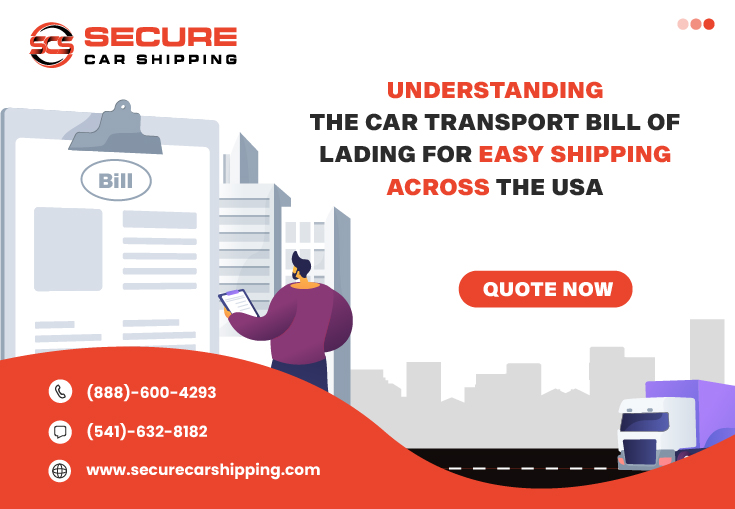
Understanding the Car Transport Bill of Lading for Easy Shipping Across the USA
Shipping a car can feel overwhelming, especially when dealing with paperwork. One important document in this process is the car transport bill of lading. But what is it, and why does it matter?
A car transport bill of lading is a legal document used in vehicle shipping. It works as both a contract and a receipt between you and the shipping company. This document includes key details like pickup and delivery locations, the vehicle’s condition, and shipping terms.
The bill of lading is important because it ensures clear communication and protection for both you and the carrier. It records the car’s condition before and after transport, preventing disputes. If there is any damage, this document helps in filing claims.
For a smooth and hassle-free car shipping experience, always check the bill of lading carefully before signing. Choosing a reliable transporter also makes a big difference. If you are looking for the best car shipping company in California, make sure they provide a clear and detailed bill of lading for your safety and peace of mind.
Benefits of Car Shipping Bill of Lading:
Just take a minute and think what if your car arrives at its destination with a new dent or scratch? Without a car transport bill of lading, proving that the damage was not there before can be difficult. This document is important because it shows your car’s condition before and after shipping. If there is any damage, you can use it as proof to make a claim easily and avoid stressful disputes.
The bill of lading is not just a simple document; it is a protection for both you and the shipping company.
Benefits for Car Owners:
- It serves as proof of the agreement between you and the carrier, including pickup and delivery locations, timeframes, and any special instructions.
- It acts as a receipt, confirming that you handed your car over to the transport company and that it was delivered to the right place.
- It records your car’s condition before transport, so if there is any new damage upon arrival, you can use the bill of lading to file a claim.
Benefits for Carriers:
- It protects them from false claims by clearly documenting the car’s condition before transport.
- It guides them on delivery details, including locations and any special instructions.
- It ensures transparency in the shipping process, reducing misunderstandings or disputes.
By making sure that the car transport bill of lading is accurate and complete, both the car owner and the transport company can enjoy a smooth and stress-free shipping process.
Structure of Bill of Lading in Auto Transport Companies:
A car transport bill of lading contains several important sections. Below is a breakdown of each part:
1. Shipper and Consignee Information
This section contains details about the sender and receiver of the car. It includes your full name, address, and contact details, along with the recipient’s name, address, and phone number. Having correct details ensures smooth communication and proper delivery of your vehicle.
2. Carrier Details
This section provides information about the transport company, including the company name, MC/DOT number (for verifying their legitimacy), company address, and contact information. This ensures you are working with a trustworthy and registered transport service.
3. Vehicle Identification
The bill of lading includes details about your car such as its year, make, and model, Vehicle Identification Number (VIN), license plate number, and current mileage. Recording mileage ensures that your car was only moved for necessary tasks like loading and unloading.
4. Pickup and Delivery Information
This section includes the pickup and drop-off locations, expected delivery date, special delivery instructions such as expedited shipping or terminal drop-off, and whether the location is residential or commercial. Providing correct addresses helps avoid delays or delivery issues.
5. Vehicle Condition Report
This is one of the most important sections. It records existing dents, scratches, and other marks, confirmation from both you and the driver, and timestamped or geo-tagged photos for extra proof. If damage occurs during transport, this report helps in filing a claim quickly.
6. Payment Terms
This section explains the total cost of shipping your car, the payment methods you can use, and when the payment is due. Having clear payment terms helps avoid confusion or surprise charges. Knowing the cost and payment details in advance ensures a smooth process and helps both you and the transport company stay on the same page.
7. Liability and Insurance Information
The bill of lading includes the carrier’s liability coverage in case of damage during shipping and additional insurance options. It is always a good idea to check with your own insurance provider to ensure there are no gaps in coverage.
8. Additional Documentation
Depending on your situation, you may need extra documents. These include Lienholder Authorization, which is required if your car is financed or leased. Proof of Ownership may be needed in the form of a title or registration copy. Some carriers may ask for your insurance details for added protection. A valid Photo ID may be required for identity verification. Customs Documents are necessary for international shipments. Special Instructions may be required for custom or modified vehicles. It is best to check with your carrier in advance to make sure you have all necessary documents ready.
Conclusion:
The car transport bill of lading is a key document that protects both the car owner and the shipping company. It ensures a clear, transparent, and organized vehicle transport process. By understanding its importance and structure, you can make your car shipping experience smooth and stress-free.
If you are looking for the best car shipping company in California, make sure they provide a detailed and reliable bill of lading to ensure a safe and hassle-free transport process.
